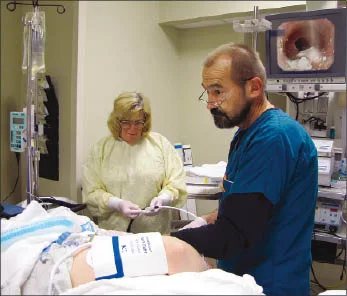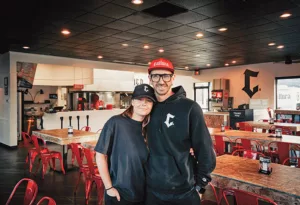
Home » Heartburn's SERIOUS SIDE
Heartburn's SERIOUS SIDE
Rockwood begins offering esophageal ablation procedure to prevent cancer

October 29, 2009
Rockwood Clinic PS, of Spokane, has begun offering what it says is a more desirable treatment for a potentially dangerous problem in the esophagus that results from frequent and long-occurring acid reflux.
Acid reflux, which is the leakage of gastric acid upward from the stomach, can cause a mutation in the esophagus's cellular lining. In the past, that condition, called Barrett's esophagus, has been monitored on a regular basis using an endoscope to identify whether it was developing into a form of cancer, and was treated with alternative therapies that lead to undesirable complications.
Now, say doctors at Rockwood Clinic, a procedure is available here to destroy those mutated cells through an endoscopic ablation, which can be done on an outpatient basis.
The procedure was performed for the first time here Oct. 14, at the Rockwood Digestive Health Center, which is located in Providence Sacred Heart Medical Center & Children's Hospital, say the center's Dr. Harold Preiksaitis and Dr. Zdenek Bocek.
Preiksaitis and Bocek say they believe Rockwood is the only provider of the Barrett's tissue ablation procedure in the Spokane-Coeur d'Alene area. The technology has been commercially available in the U.S. since 2005, and was cleared by the U.S. Food and Drug Administration in 2001 for use on patients.
Barrett's esophagus itself doesn't cause symptoms, but the acid reflux that causes the condition results in heartburn. The esophagus is the muscular swallowing tube that carries foods and liquids from the mouth to the stomach
"The lining of the esophagus and the lining of the stomach are different, and the esophagus can't take the acid," Preiksaitis says.
About 13 percent of people who have chronic acid reflux also have Barrett's esophagus, which affects an estimated 3.3 million U.S. adults, he says. With Barrett's esophagus, a form of cancer called adenocarcinoma can form, which then can invade other tissues.
Barrett's esophagus is diagnosed with an endoscope, a small flexible tube with a camera and light at the end, which is guided into the mouth and down the esophagus. The camera enables doctors to see any acid damage. Endoscopy is a nonsurgical procedure and typically is performed using conscious sedation medications. During the endoscopy, some tissue may be obtained to confirm a diagnosis of Barrett's esophagus.
Traditionally, when patients have been diagnosed with Barrett's esophagus they faced a lifetime of regular endoscopic surveillance procedures and biopsies, generally every one to three years, intended to watch the progression of the condition and the possibility of cancer forming.
"The advantage (of ablation) is you're getting rid of it and you don't have to come back," says Bocek.
The less desirable alternatives to endoscopic ablation include photodynamic therapy, in which a light-sensitizing agent and a laser are used to kill precancerous and cancerous cells, Preiksaitis says. Complications from the therapy include chest pain, nausea, sun sensitivity for several weeks, and esophageal strictures. Another alternative is endoscopic mucosal resection, which involves lifting the Barrett's lining and injecting a solution under it or applying suction to it and then cutting it off. The lining is then removed through the endoscope, but complications of the treatment can include bleeding or tearing of the esophagus. The two alternatives are sometimes used in combination, Preiksaitis says.
He and Preiksaitis say that even considering the cost of the ablation treatment, patients who undergo the procedure save money in the long run compared with those who have regular surveillance procedures and biopsies.
In the procedure, a specialized device developed by Sunnyvale, Calif.-based Barrx Medical Inc. is guided into the esophagus, either next to an endoscope or attached to it. Once in place the device delivers a dose of radiofrequency energy to the mutated cells, essentially killing them with heat, Bocek says.
No incisions are necessary, and patients go home the same day, the doctors say.
Barrett's tissue is thin and therefore is a good candidate for removal with ablative energy, the doctors say. Once the bad tissue is destroyed, the body begins to regenerate the normal lining of the esophagus, the doctors say. Without the ablation, the Barrett's esophagus tissue doesn't goes away.
Large areas of Barrett's tissue can be treated with a balloon-based ablation catheter, called a HALO360, which is guided to the damaged area on its own catheter, while smaller, more targeted areas can be treated with the HALO90, which can be mounted on the endoscope. Bocek and Preiksaitis say that each HALO device, which is used only once, costs about $1,700.
They say doctors at the Rockwood center expect to do about three to four such ablation procedures a month. About seven doctors at the center have been trained to perform the procedure.
Preiksaitis and Bocek say that clinical studies have shown Barrett's tissue can be eliminated completely with the HALO ablation technology in 98 percent of patients.
Without the treatment, the surveillance endoscopies and biopsies continue for the life of the patient or until the condition is shown to progress to more dangerous stages, such as cancer or what is called dysplasia, a step before cancer. Dysplasia is an abnormality of a tissue or cell that makes it more cancer-like and disorganized, the doctors say.
If progression of adenocarcinoma is detected or sometimes when high-grade dysplasia is found, surgical removal of the entire esophagus becomes necessary, after which the stomach is usually pulled upward into the chest so food can reach it, Preiksaitis says.
Esophageal cancer of this type is the fastest growing cancer in the U.S., in terms of the number of new cases per year, the doctors say.
They say that as obesity continues to become more common, the number of people with acid reflux also will grow, and that will contribute to an increase in the number of people who develop esophageal adenocarcinoma.
Still, esophageal cancer is relatively uncommon in the U.S., and occurs most often in men who are at least 50 years old, the National Institutes of Health says. It strikes less than five in 100,000 people. There are two main types of esophageal cancer—squamous cell carcinoma and adenocarcinoma, NIH says.
Squamous cell esophageal cancer is associated with smoking and alcohol consumption. The rate of this disease in the U.S. has remained mostly the same, while the rate of adenocarcinoma of the esophagus has risen dramatically, NIH says.
Bocek and Preiksaitis say that by the time symptoms of esophageal cancer surface—such as when a patient has difficulty swallowing—the cancer is probably already fairly advanced.
"It tends to spread very quickly, and if it gets into the chest area it is bad stuff," Preiksaitis say.
The doctors say that although zapping the Barrett's tissue with radiofrequency ablation eliminates the bad tissue and stimulates the regeneration of normal esophagus lining, it doesn't cure the acid reflux that led to Barrett's esophagus in the first place. So acid reflux must continue to be treated, and lifestyle changes must be made including improved nutrition and stopping smoking.
Latest News
Related Articles



_web.webp?t=1764835652)